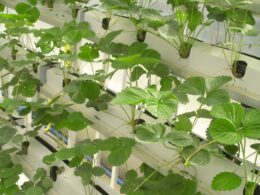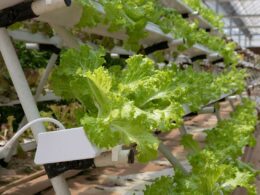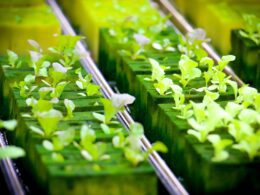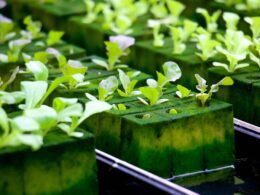Are you interested in hydroponic gardening but don’t know where to start? With so many different methods out there, it can be overwhelming to choose the most efficient one for your needs. But fear not, we’re here to guide you through the process.
Hydroponic gardening is a soilless method of growing plants that relies on water and nutrients to feed the roots. This method has become increasingly popular in recent years due to its efficiency and ability to produce high yields in small spaces.
In this article, we’ll explore the three most popular hydroponic methods – Deep Water Culture (DWC), Nutrient Film Technique (NFT), and Aeroponics – and help you determine which one is the most efficient for your gardening goals.
So, let’s dive in and see which method is right for you!
Overview of Hydroponic Gardening
If you’re looking for a way to grow plants without soil, you’ll want to read up on the fascinating world of hydroponic gardening. Hydroponic gardening is a method where plants are grown in a nutrient-rich water solution instead of soil. This method is becoming increasingly popular, especially for indoor gardening, as it allows for more control over the plants’ environment and maximizes space efficiency.
One of the main benefits of hydroponic gardening is its sustainability in agriculture. By using less water and avoiding soil erosion, hydroponic gardening is a more eco-friendly option for growing plants. Additionally, hydroponic gardening allows for year-round growing, regardless of the weather outside.
With the right equipment and setup, you can grow a variety of plants, including fruits and vegetables, herbs, and even flowers.
Overall, hydroponic gardening is an efficient and effective way to grow plants without soil. It offers many benefits, including sustainability in agriculture and year-round growing. Whether you’re an experienced gardener or just starting out, hydroponic gardening’s definitely worth exploring.
Deep Water Culture (DWC)
If you’re looking for a simple and efficient hydroponic method, Deep Water Culture (DWC) might be the one for you. With DWC, plants are grown in a nutrient-rich water solution, with their roots submerged in the water.
One of the advantages of DWC is that it requires minimal maintenance and can yield high-quality produce. However, it’s important to note that DWC can also have its disadvantages, such as the risk of root rot and the need for a constant supply of electricity.
When it comes to the best plants to grow in DWC, leafy greens and herbs tend to thrive in this type of system.
How DWC Works
Now you’re floating in a tank of water with roots suspended in the nutrient-rich solution, allowing your plants to thrive and grow in the Deep Water Culture hydroponic system. DWC is one of the most efficient hydroponic methods available due to its simplicity and low maintenance.
The advantages of DWC include the ease of setup, the low cost of materials, and the reduced amount of water and nutrients needed to sustain the plants. Maintaining a DWC system is also relatively easy.
You’ll need to monitor the water level and pH levels regularly to ensure that the plants are receiving the correct amount of nutrients. You may also need to trim the roots occasionally to prevent them from becoming tangled and inhibiting plant growth. However, with a little bit of attention and care, your DWC system can provide you with a bountiful harvest of fresh, healthy produce.
So sit back, relax, and let your plants thrive in the nutrient-rich waters of the Deep Water Culture hydroponic system.
Advantages and Disadvantages
You’ll learn about the benefits and drawbacks of using the Deep Water Culture hydroponic system in this section, so you can make an informed decision about whether it’s right for you.
One of the main advantages of DWC is that it requires less water than traditional farming. In traditional farming, water is absorbed by the soil, which means that a lot of water gets wasted. However, in DWC, water is recirculated, so you don’t need to use as much water. This makes it an eco-friendly option for those who care about sustainability.
Another advantage of DWC is that it allows for better control over the plants’ environment. With DWC, you can easily adjust the pH levels of the water and the nutrient levels, which means that you can ensure that your plants are getting the right amount of nutrients they need to grow.
However, one of the main drawbacks of DWC is that it can be more expensive than traditional farming. The cost of setting up a DWC system can be quite high, which may not be feasible for those who are on a tight budget. Additionally, DWC requires electricity to run the water pump, so you may end up spending more money on your electricity bill.
Ultimately, when deciding whether DWC is the right hydroponic method for you, it’s important to weigh the pros and cons and compare it with traditional farming to see which option is more cost-effective and sustainable in the long run.
Best Plants to Grow
Growing plants in a Deep Water Culture hydroponic system can be satisfying and rewarding. This method is particularly effective for lettuce, spinach, and other leafy greens known for their fast growth rates and high yields.
To ensure optimal growing conditions, it’s important to provide the plants with enough light, nutrients, and oxygen. With the Deep Water Culture system, this is easily achieved by providing a nutrient-rich solution and ensuring well-aerated roots.
With the right care and attention, you can expect healthy growth and bountiful harvests from your hydroponic garden.
Nutrient Film Technique (NFT)
With NFT, you can effortlessly cultivate your plants without any hassle and ensure they receive the nutrients they need to flourish.
NFT design is simple, consisting of a sloping channel that allows a thin film of nutrient-rich water to flow over the roots of plants.
This technique is ideal for growing plants that require a high level of oxygen, such as lettuce, herbs, and strawberries.
To maintain an NFT system, you need to ensure that the channel is always sloping towards the outlet and that the nutrient solution is flowing continuously.
Keep an eye on the pH level of the nutrient solution and adjust it as needed to ensure that your plants are getting the right nutrients at the right time.
Also, make sure to clean the system regularly to avoid any blockages that may affect the flow of water.
In addition to being easy to maintain, the NFT method also has a low water requirement and is highly efficient in terms of nutrient uptake.
With a well-designed NFT system, you can grow plants faster and with less water than traditional soil-based methods.
So, if you’re looking for a hydroponic method that’s both efficient and easy to maintain, consider giving NFT a try.
Aeroponics
If you’re looking for a high-tech way to grow plants that involves misting their roots with nutrient-rich water, then aeroponics might be the perfect method for you. This hydroponic system uses a technique called aeroponic misting, which involves spraying a fine mist of water and nutrients onto the plant’s roots suspended in the air.
This system allows for maximum oxygenation of the roots and increases nutrient uptake, resulting in faster growth and higher yields. There are two types of aeroponic systems: low-pressure and high-pressure.
Low-pressure aeroponics uses a mister to spray the roots with nutrient water, while high-pressure aeroponics uses a high-pressure pump to create a fine mist that is sprayed onto the roots.
High-pressure aeroponics is more efficient and can deliver more nutrients to the plant’s roots, resulting in faster growth and higher yields. However, it requires more maintenance and can be expensive to set up.
Overall, aeroponics is a highly efficient hydroponic method that can produce faster growth and higher yields. With the use of high-pressure aeroponics, the nutrient uptake is maximized, leading to healthier and more productive plants. However, it’s important to note that aeroponics requires precise monitoring and maintenance to ensure optimal growth conditions. If you’re willing to invest in a high-tech hydroponic system and have the time and resources to maintain it, aeroponics is definitely worth considering.
Choosing the Most Efficient Hydroponic Method
Looking for the perfect way to grow your plants? When it comes to hydroponic system selection, efficiency and yield optimization are key factors to consider. There are several hydroponic methods to choose from, each with its own advantages and disadvantages. But which one is the most efficient?
One of the most efficient hydroponic systems is the Deep Water Culture (DWC) method. This system involves suspending plant roots in nutrient-rich water, allowing for maximum oxygenation and nutrient uptake. The simplicity of the DWC system also means that it’s relatively easy to set up and maintain, making it a popular choice for beginners.
Another efficient hydroponic method is the Nutrient Film Technique (NFT). This system uses a thin film of nutrient-rich water flowing over the plant roots, providing a constant supply of nutrients and oxygen. The NFT system is highly efficient in terms of water usage, and it’s also a good choice for small spaces due to its compact design.
In summary, when choosing the most efficient hydroponic method, it’s important to consider factors such as yield optimization, ease of setup and maintenance, and water usage. While there are several options available, the Deep Water Culture and Nutrient Film Technique methods are both highly efficient and effective choices for growing plants hydroponically.
Frequently Asked Questions
What is the cost range for setting up a hydroponic system using any of the mentioned methods?
When considering the cost of setting up a hydroponic system, there are several factors to keep in mind. Conducting a cost benefit analysis is essential. While hydroponic systems can be more expensive upfront, they often result in higher yields and faster growth rates, making them a wise investment in the long run.
Additionally, sustainability considerations should be taken into account. Hydroponic systems can conserve water and reduce the need for harmful pesticides and fertilizers. These benefits can help offset the initial cost of setting up a hydroponic system.
Ultimately, it’s important to weigh the costs and benefits of different methods and choose the one that best fits your needs and budget.
How long does it take to set up a hydroponic system and start growing plants?
Starting your own hydroponic system can be a quick and easy process. Depending on the size and complexity of your system, it can take anywhere from a few hours to a few days to set up and start growing plants.
One of the benefits of hydroponic gardening for urban dwellers is the ability to grow plants in a small space, whether it’s indoors or outdoors. Indoor systems can be set up in a spare room or even a closet, while outdoor systems can be set up on a balcony or rooftop.
When comparing indoor and outdoor hydroponic systems, it’s important to consider factors such as lighting, temperature control, and accessibility.
Overall, hydroponic gardening is a great way to grow fresh produce in a controlled environment, and with a little time and effort, you can have a thriving garden in no time.
What are the most common mistakes beginners make when starting a hydroponic garden?
Common mistakes can easily derail your hydroponic garden, but with some expert advice and troubleshooting tips, success stories are within reach.
One common mistake beginners make is overfeeding their plants, which can lead to nutrient burn and stunted growth. It’s important to follow a feeding schedule and monitor your plants’ growth.
Another mistake is not properly maintaining your system, such as neglecting to clean the roots or changing the water regularly. This can lead to root rot and other issues.
To avoid these mistakes, research and planning are key. With the right approach, you can enjoy a thriving hydroponic garden.
How often should the water and nutrients be changed in a hydroponic system using any of the mentioned methods?
To maintain a healthy hydroponic system, it’s crucial to change the water and nutrients regularly. The optimal nutrient ratios need to be maintained as per the requirements of the plants.
Also, the pH balance needs to be checked regularly to ensure that the water is within the range of 5.5-6.5. Neglecting these essentials could lead to root rot, algae growth, and nutrient deficiencies, which could ultimately result in stunted plant growth.
So, it’s important to pay attention to the water quality and ensure that it is changed every 1-2 weeks, while the nutrient solution should be changed every 2-3 weeks. This simple routine will ensure that your hydroponic system is working efficiently, and your plants are thriving.
Can any type of plant be grown using hydroponic gardening, or are there certain plants that are not suitable for this method?
Looking to switch to hydroponic gardening? You’re in luck!
There are a wide variety of plants that are suitable for this method, including lettuce, herbs, strawberries, and even tomatoes.
One of the advantages of hydroponic farming over traditional methods is that you can control the nutrients and environment of your plants, leading to faster growth and higher yields.
Plus, because hydroponic systems don’t require soil, there’s less chance of pests and diseases.
So whether you’re a seasoned gardener or just starting out, hydroponic gardening is a great option for growing a variety of plants in a safe and controlled environment.
Conclusion
So, you’re interested in hydroponic gardening and want to know the most efficient method? Well, after exploring Deep Water Culture (DWC), Nutrient Film Technique (NFT), and Aeroponics, the answer isn’t simple.
Each method has its own advantages and disadvantages, and the most efficient one for you might depend on factors such as space, budget, and the types of plants you want to grow.
Ultimately, it’s up to you to decide which method suits your needs best. Don’t be afraid to experiment and try different methods until you find the one that works for you.
Happy gardening!









